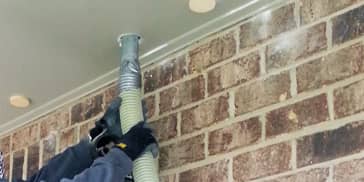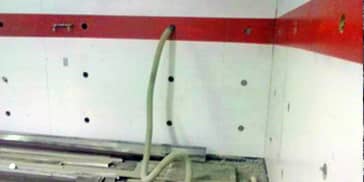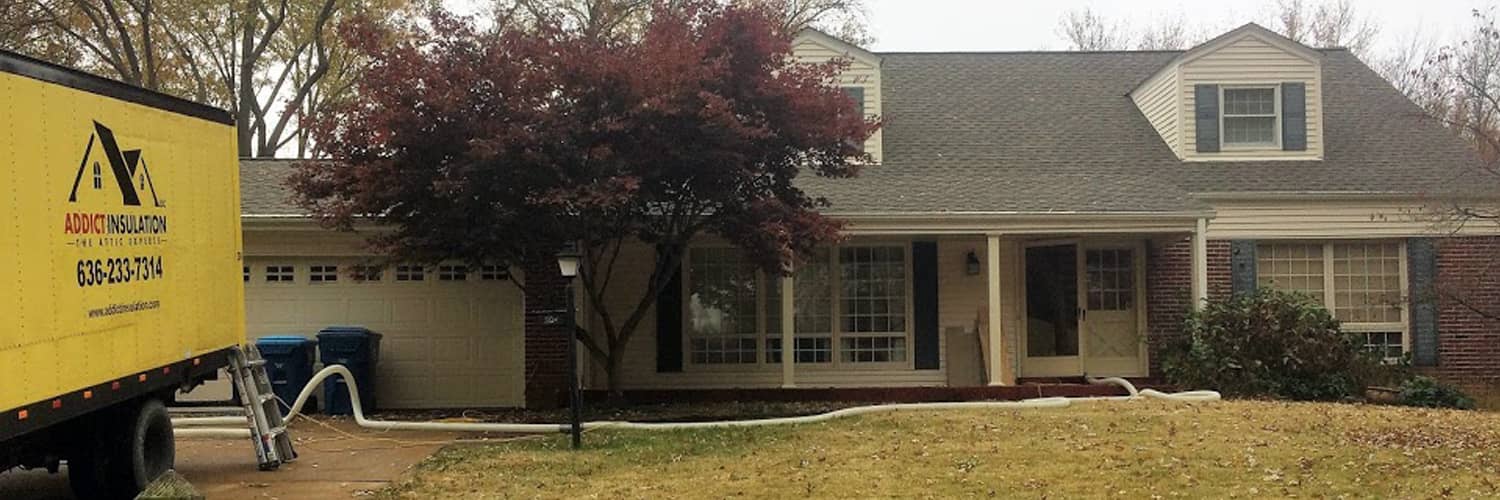St Louis - St Charles Insulation Company.


Can insulation be added to existing walls?
Yes, You can add insulation to existing walls of older homes without removing drywall. How we install insullation in cloded ceiling and walls is the process of Drill & Fill Insulation.
What is Drill and Fill Insulation?
If you’re thinking about replacing your home’s insulation, you may have heard of drill and fill insulation but aren’t sure what it is. This method is essentially the only way to re-insulate any existing wall. Over time, the exterior walls of your home may have to be re-insulated to cut down on heat flow.
This type of insulation in St. Charles MO can be applied to the inside of walls, filling the cavities for a more comfortable and energy-efficient home. It also happens to be an excellent source of soundproofing. Proper installation by professionals is highly recommended.
Drill and fill is just what it sounds like. Small holes are drilled into each wall bay, then cellulose insulation is blown right into the ceiling or wall to fill it up. An insulation blowing machine is used to apply the insulation. This technique ensures every nook and cranny is filled with insulation, something traditional batt insulation simply can’t do.
The Process Of Drill & Fill Insulation
Here’s a quick look at the process:
1. Drilling is done either from the inside or the outside of the house. Your installation expert will assess the situation and determine the best method.
2. The contractor will drill one- to two-inch diameter holes into each bay.
3. One installer will operate the hose to fill up each hole, while the other installer will operate the blowing machine.
4. Both installers use cellulose insulation to fill each wall bay for maximum insulation.
5. After all holes and bays have been filled with cellulose insulation, they will patch each hole up.
6. This process can also be utilized to fill the space between floors, which reduces sound transfer.
Benefits of Drill and Fill Insulation
Homes built before 1979 usually don’t have much wall insulation. In many homes, batt insulation has been used, but it doesn’t provide complete coverage. This results in the escape of heat. Drill and fill remedies this problem because it offers total coverage. Because it’s blown in, it expands to fill every available space.
This coverage allows for the highest possible R-value for wall insulation, which is a measurement of how effective insulation is in different parts of the home. If you have an older home that already has old batt wall insulation, drill and fill techniques are ideal when it comes to re-insulating the walls and providing maximum R-value coverage. You spend less on energy bills, retain more heat in the winter and cold air in the summer, and experience higher levels of comfort with the home.
Drill and fill insulation forms a barrier that seals cracks and openings around objects leading outdoors, such as cables, pipes, basement doors, and more.
Homes without proper wall insulation experience home comfort problems, such as:
- Excessively high cooling or heating costs
- Uneven cooling and heating throughout the house
- HVAC system works over time, stressing the unit and costing you more $$$
- Walls are noticeably cold to the touch
The drill-and-fill process is an effective installation method that can be done in any home, but particularly older homes that need to be re-insulated in the most non-invasive way possible.
Not sure if your home qualifies for drill and fill insulation? Ask a professional!
Proper insulation is the top way to curb air escape from your home. Another thing you can do is seal cracks and openings to reduce drafts and cold spots, suggests Energy.gov. It’s important to prevent air leakage, which, if left unchecked, can contribute to moisture problems that can affect occupants’ health and the home’s durability.
Contact Addict Insulation
To learn more about drill and fill insulation in St. Charles MO, contact us at 636-233-7314.
Not sure which type of insulation is best for your older home in Missouri? No problem. Let our experts come out and assess the situation.
Missouri Insulation Company
Popular Articles
- FAQs About Insulation in Missouri
- What Areas Should You Insulate Before Winter?
- The Greatest Risks to Your Home Caused by Poor Insulation
- Why Your Utility Bills Are So High and What You Can Do About It
- Can You Put New Insulation Over Old?
- Here Are 3 Ways Your Attic Could be Contaminated
- How Home Insulation Works in the Summer
- Tips and Tricks For Summer Insulation
- How to Fix Indoor Condensation
- Choosing the Right Spray Foam Contractor
- Why You Need Power Washing This Spring
- Don't Let Air Escape Your Home
- Tips For Saving on Your Energy Bills This Summer
- Should I Install a Radiant Barrier in My Home?
- Are You Wondering if Your Attic Has Enough Insulation?
- Do I Have to Replace Wet Insulation?
- Insulating Your Sunroom
- Should You Insulate Your Outdoor Spaces?
- All About Removing Insulation
- What to Know About Insulating a Crawl Space
- How to Spot Mold in Your Wall Insulation
- How to Prevent Moisture in Your Warehouse With Spray Foam Insulation
- What Factors Cause Heat Gain?
- The Problems That Come With Improper Insulation
- Insulation FAQs
- Why Should You Check the Insulation When Buying a Home?
- Why Seal and Insulate Your Home?
- Home Insulation: Safety and Health
- Should You Remove Old Insulation During Replacement?
- Can I Stay Inside My Home During Spray Foam Insulation Installation?
- Pros and Cons of Converting an Attic
- Pros and Cons of Converting an Attic
- When’s the Best Time to Insulate Your House?
- The Difference Between Blown Insulation and Spray Foam Insulation
- Is Your Garage Loft Too Hot or Too Cold? Heed These Tips
- 6 Health Benefits of Having a Quiet Home
- Insulation Prep is Critical For Installation
- The Dangers of Removing Insulation on Your Own
- What’s the Most Eco-Friendly Insulation?
- 7 Benefits of Spray Foam Insulation
- What is the Proper Insulation For Vaulted Ceilings?
- Signs Your Crawlspace Insulation Should be Replaced
- Why You Should Insulate Your Basement Walls
- Most Effective Ways to Soundproof Your Home Office
- How to Insulate an Old House
- 4 Tips to Make Your Attic More Energy Efficient
- Attic Insulation Problems: 5 Things to Look Out For
- What Causes Condensation on Interior Walls?
- How Deep Should Your Insulation Be?
- What to Consider When Choosing an Insulation Company
- Can You Add New Insulation Layers Over Old Ones?
- When Should You Remove Insulation?
- 7 Tips For an Energy Efficient Summer
- Creating a Healthy, Comfortable and Productive Workspace When Working From Home
- Why is Roof Ventilation Just as Important as Insulation?
- Why Spring is a Good Time to Insulate Your Attic
- 5 Signs of Damaged or Insufficient Insulation
- Is the Insulation in Your Walls Making You Sick?
- Under-Insulated Areas You May Be Overlooking
- The History Of Insulation.
- Pros and Cons of Attic Insulation
- Do You Need Insulation When Finishing a Basement?
- What is Drill and Fill Insulation?
- Which Insulation is Best for Garage Walls?
- How Air is Escaping Your Home and How to Prevent It
- 10 Things You Must Absolutely Insulate Before Winter
- 5 Reasons To Not DIY Insulation
- 5 Signs of an Under-Insulated Home
- 5 Benefits of Blown Insulation
- Cellulose vs. Fiberglass Insulation
- When is Insulation Removal Necessary?
- Tips to Keep Your Home Cool This Summer
- What is the Best Insulation for a Flat Roof?
- 5 Benefits of Power Washing
- Q & A About Insulation
- Reviews
- Energy Saving Blog






